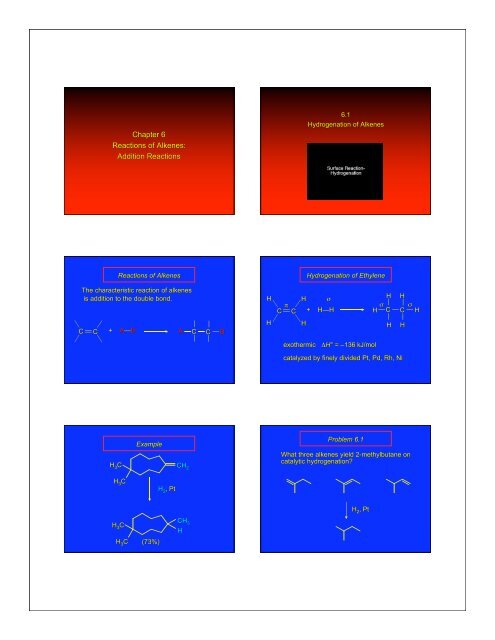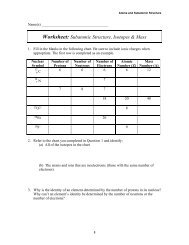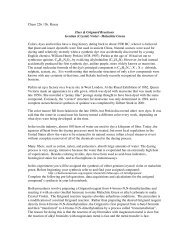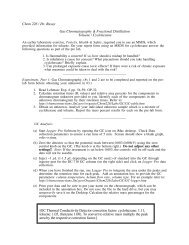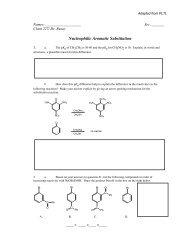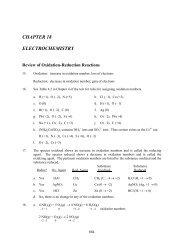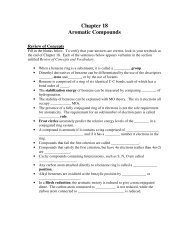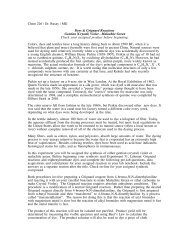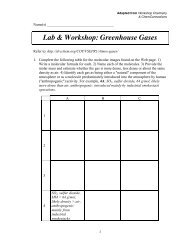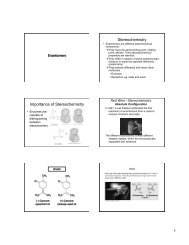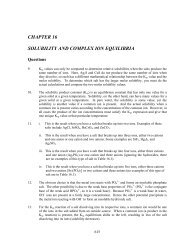Chapter 6 Reactions of Alkenes: Addition Reactions
Chapter 6 Reactions of Alkenes: Addition Reactions
Chapter 6 Reactions of Alkenes: Addition Reactions
Create successful ePaper yourself
Turn your PDF publications into a flip-book with our unique Google optimized e-Paper software.
<strong>Chapter</strong> 6<br />
<strong>Reactions</strong> <strong>of</strong> <strong>Alkenes</strong>:<br />
<strong>Addition</strong> <strong>Reactions</strong><br />
6.1<br />
Hydrogenation <strong>of</strong> <strong>Alkenes</strong><br />
<strong>Reactions</strong> <strong>of</strong> <strong>Alkenes</strong><br />
The characteristic reaction <strong>of</strong> alkenes<br />
is addition to the double bond.<br />
+ A—B<br />
C C A C C B<br />
H<br />
H<br />
H σ<br />
H H<br />
π<br />
σ σ<br />
C C + H—HH<br />
H C C H<br />
H<br />
Hydrogenation <strong>of</strong> Ethylene<br />
exothermic ΔH° = –136 kJ/mol<br />
catalyzed by finely divided Pt, Pd, Rh, Ni<br />
H<br />
H<br />
H 3 C<br />
Example<br />
CH 2<br />
Problem 6.1<br />
What three alkenes yield 2-methylbutane on<br />
catalytic hydrogenation<br />
H 3 C<br />
H 2 , Pt<br />
H 2 , Pt<br />
H 3 C<br />
CH 3<br />
H<br />
H 3 C<br />
(73%)
Question 2<br />
Which <strong>of</strong> the alkenes below will produce 2-<br />
methylbutane on catalytic hydrogenation<br />
A) 1 and 3<br />
B) 1, 2 and 3<br />
C) 2 and 4<br />
D) 2, 3 and 4<br />
6.2<br />
Heats <strong>of</strong> Hydrogenation<br />
can be used to measure relative stability<br />
<strong>of</strong> isomeric alkenes<br />
correlation with structure is same as<br />
when heats <strong>of</strong> combustion are measured<br />
Heats <strong>of</strong> Hydrogenation <strong>of</strong> Isomers<br />
Heats <strong>of</strong> Hydrogenation (kJ/mol)<br />
Ethylene 136<br />
Monosubstituted 125-126<br />
126<br />
126<br />
119<br />
119<br />
115<br />
115<br />
cis-Disubstituted<br />
117-119<br />
trans-Disubstituted<br />
114-115<br />
Terminally disubstituted 116-117<br />
Trisubstituted 112<br />
CH 3 CH 2 CH 2 CH 3<br />
Tetrasubstituted 110<br />
Question 1<br />
Rank the following alkenes in order <strong>of</strong><br />
decreasing heat <strong>of</strong> hydrogenation.<br />
Match each alkene <strong>of</strong> Problem 6.1 with its correct<br />
heat <strong>of</strong> hydrogenation.<br />
126 kJ/mol<br />
Problem 6.2<br />
highest heat <strong>of</strong><br />
hydrogenation;<br />
least stable isomer<br />
A) 1 > 3 > 2<br />
B) 3 > 2 > 1<br />
C) 2 > 3 > 1<br />
D) 1 > 2 > 3<br />
118 kJ/mol<br />
112 kJ/mol<br />
lowest heat <strong>of</strong><br />
hydrogenation;<br />
most stable isomer
Question 4<br />
Which alkene has the lowest heat <strong>of</strong><br />
hydrogenation<br />
A) B)<br />
6.3<br />
Stereochemistry <strong>of</strong> Alkene<br />
Hydrogenation<br />
C) D)<br />
Catalytic Hydrogenation <strong>of</strong> an Alkene<br />
Two Spatial (stereochemical) Aspects <strong>of</strong><br />
Alkene Hydrogenation<br />
(1) syn addition <strong>of</strong> both H atoms to double bond (adds<br />
from the same side)<br />
(2) hydrogenation is stereoselective,<br />
corresponding to addition to less crowded face <strong>of</strong><br />
double bond<br />
Two Spatial (stereochemical) Aspects <strong>of</strong><br />
Alkene Hydrogenation<br />
syn <strong>Addition</strong> versus anti <strong>Addition</strong><br />
(1) syn addition <strong>of</strong> both H atoms to double bond<br />
syn addition<br />
anti addition
Example <strong>of</strong> syn-<strong>Addition</strong><br />
Question<br />
CO 2 CH 3<br />
H 2 , Pt<br />
H<br />
CO 2 CH 3<br />
CO 2 CH 3<br />
H 2 , Pt<br />
H<br />
CO 2 CH 3<br />
CO 2 CH 3<br />
H<br />
(100%)<br />
CO 2 CH 3<br />
CO 2 CH 3<br />
True (A) / False (B)<br />
The hydrogenation product is a chiral<br />
molecule.<br />
H<br />
CO 2 CH 3<br />
Two Spatial (stereochemical) Aspects <strong>of</strong><br />
Alkene Hydrogenation<br />
(1) syn addition <strong>of</strong> both H atoms to double bond<br />
(2) hydrogenation is stereoselective,<br />
corresponding to addition to less crowded<br />
face <strong>of</strong> double bond<br />
Two Spatial (stereochemical) Aspects <strong>of</strong><br />
Alkene Hydrogenation<br />
(1) syn addition <strong>of</strong> both H atoms to double bond<br />
(2) hydrogenation is stereoselective,<br />
corresponding to addition to less crowded face<br />
<strong>of</strong> double bond<br />
A reaction in which a single starting material<br />
can give two or more stereoisomeric products<br />
but yields one <strong>of</strong> them in greater amounts than<br />
the other (or even to the exclusion <strong>of</strong> the other)<br />
is said to be stereoselective.<br />
H<br />
H 3 C<br />
CH 3<br />
Example <strong>of</strong><br />
Stereoselective<br />
Reaction<br />
H<br />
H 3 C<br />
CH 3<br />
Example <strong>of</strong><br />
Stereoselective<br />
Reaction<br />
H 3 C<br />
H 2 , cat<br />
H 3 C<br />
H 2 , cat<br />
H 3 C<br />
H<br />
CH 3<br />
H 3 C<br />
H<br />
CH 3<br />
H 3 C<br />
H<br />
CH 3<br />
H<br />
H 3 C<br />
H<br />
Both products<br />
correspond to<br />
syn addition<br />
<strong>of</strong> H 2 .<br />
H<br />
H<br />
H 3 C<br />
H<br />
H 3 C<br />
H<br />
But only this<br />
one is formed.
H<br />
H 3 C<br />
CH 3<br />
Example <strong>of</strong><br />
Stereoselective<br />
Reaction<br />
H<br />
H 3 C<br />
CH 3<br />
Example <strong>of</strong><br />
Stereoselective<br />
Reaction<br />
H 3 C<br />
H 2 , cat<br />
H 3 C<br />
H 2 , cat<br />
H 3 C<br />
H<br />
Top face <strong>of</strong> <strong>of</strong> double<br />
bond blocked by by<br />
this methyl group<br />
CH 3<br />
H 3 C<br />
H<br />
CH 3<br />
H<br />
H 3 C<br />
H<br />
H<br />
H 3 C<br />
H<br />
H 2 adds to to<br />
bottom face <strong>of</strong> <strong>of</strong><br />
double bond.<br />
Question 14<br />
Which one <strong>of</strong> the following terms best applies to<br />
the hydrogenation <strong>of</strong> an alkene in the<br />
presence <strong>of</strong> finely divided platinum (in<br />
ethanol as solvent)<br />
A) anti addition<br />
B) concerted reaction<br />
C) heterogeneous catalysis<br />
D) endothermic reaction<br />
6.4<br />
Electrophilic <strong>Addition</strong> <strong>of</strong><br />
Hydrogen Halides to<br />
<strong>Alkenes</strong><br />
Electrophilic <strong>Addition</strong>s: <strong>Alkenes</strong><br />
When the Electrophile is a<br />
Hydrogen Halide<br />
δ+ δ–<br />
C C + H—X<br />
H C C X
Example<br />
Mechanism<br />
CH 3 CH 2<br />
H<br />
C<br />
C<br />
CH 2 CH 3<br />
H<br />
HBr<br />
CHCl 3 , -30°C<br />
Electrophilic addition <strong>of</strong> hydrogen halides<br />
to alkenes proceeds by rate-determining<br />
formation <strong>of</strong> a carbocation intermediate.<br />
CH 3 CH 2 CH 2 CHCH<br />
2 CH 3<br />
Br<br />
(76%)<br />
Mechanism<br />
Mechanism<br />
Electrons flow from<br />
the π system <strong>of</strong> the<br />
alkene (electron rich)<br />
toward the positively<br />
polarized proton <strong>of</strong><br />
the hydrogen halide.<br />
H<br />
+C C<br />
..<br />
.. X<br />
:<br />
H<br />
..<br />
:<br />
.. X<br />
: –<br />
C<br />
C<br />
..<br />
: .. X<br />
C<br />
C<br />
H<br />
Markovnikov's Rule<br />
6.5<br />
Regioselectivity <strong>of</strong> Hydrogen Halide <strong>Addition</strong><br />
(Markovnikov's Rule)<br />
When an unsymmetrically substituted<br />
alkene reacts with a hydrogen halide,<br />
the hydrogen adds to the carbon that<br />
has the greater number <strong>of</strong> hydrogen<br />
substituents, and the halogen adds to<br />
the carbon that has the fewer hydrogen<br />
substituents.
Markovnikov's Rule<br />
Markovnikov's Rule<br />
CH 3 CH 2 CH<br />
CH 2<br />
HBr<br />
acetic acid<br />
CH 3 CH 2 CHCH 3<br />
Br<br />
(80%)<br />
CH 3<br />
CH 3<br />
C<br />
C<br />
H<br />
H<br />
HBr<br />
acetic acid<br />
CH 3<br />
CH 3<br />
C<br />
Br<br />
(90%)<br />
CH 3<br />
Example 1<br />
Example 2<br />
Markovnikov's Rule<br />
Question 6<br />
CH 3<br />
HCl<br />
0°C<br />
CH 3<br />
Cl<br />
What is the product <strong>of</strong> the reaction <strong>of</strong> 1-<br />
methylcyclohexene with HCl<br />
A) B)<br />
(100%)<br />
C) D)<br />
Example 3<br />
Mechanistic Basis for Markovnikov's Rule:<br />
Example 1<br />
6.6<br />
Mechanistic Basis for Markovnikov's Rule<br />
Protonation <strong>of</strong> double bond occurs in<br />
direction that gives more stable <strong>of</strong> two<br />
possible carbocations.<br />
CH 3 CH 2 CH<br />
CH 2<br />
HBr<br />
acetic acid<br />
CH 3 CH 2 CHCH 3<br />
Br
Mechanistic Basis for Markovnikov's Rule:<br />
Example 1 Question 3<br />
+<br />
CH 3 CH 2 CH 2 —CH<br />
2<br />
primary carbocation is less stable: not formed<br />
HBr<br />
+<br />
CH 3 CH 2 CH—CH<br />
3 + Br –<br />
Which carbocation forms when 3-methyl-2-<br />
pentene is protonated<br />
A) B)<br />
CH 3 CH 2 CH<br />
CH 2<br />
CH 3 CH 2 CHCH 3<br />
Br<br />
Mechanistic Basis for Markovnikov's Rule:<br />
Example 3<br />
Question 5<br />
The reaction <strong>of</strong> 3-methyl-1-butene with HBr<br />
produces 2-bromo-3-methylbutane and which<br />
other alkyl halide<br />
A) B)<br />
H<br />
CH 3<br />
HCl<br />
0°C<br />
CH 3<br />
Cl<br />
C) D)<br />
H<br />
secondary<br />
carbocation is<br />
less stable:<br />
not formed<br />
+<br />
H H<br />
CH 3<br />
H<br />
Question 18<br />
Which alkene reacts with HCl (electrophilic<br />
addition) at the fastest rate<br />
HCl<br />
+<br />
CH 3<br />
Cl –<br />
A) B)<br />
H<br />
CH 3<br />
CH 3<br />
Cl<br />
C) D)
Rearrangements Can Occur<br />
H 2 C<br />
CHCH(CH<br />
3 ) 2<br />
6.7<br />
Carbocation Rearrangements in Hydrogen<br />
Halide <strong>Addition</strong> to <strong>Alkenes</strong><br />
HCl, 0°C0<br />
+<br />
CH 3 CHCH(CH<br />
3 ) 2<br />
H<br />
+<br />
CH 3 CHC(CH 3 ) 2<br />
CH 3 CHCH(CH<br />
3 ) 2<br />
CH 3 CH 2 C(CH 3 ) 2<br />
Cl (40%)<br />
(60%)<br />
Cl<br />
Carbocation Rearrangements<br />
1,2-hydride shift<br />
a more stable<br />
carbocation<br />
Carbocation Rearrangements<br />
1,2-methyl shift<br />
a more stable<br />
carbocation<br />
Carbocation Rearrangements<br />
NOTE: Carbocation does not always rearrange …<br />
Ring Expansion<br />
a more stable<br />
carbocation
Markovnikov's Rule<br />
6.8<br />
Free-radical <strong>Addition</strong> <strong>of</strong> HBr to<br />
<strong>Alkenes</strong><br />
The "peroxide effect"<br />
CH 3 CH 2 CH<br />
CH 2<br />
HBr<br />
acetic acid<br />
CH 3 CH 2 CHCH 3<br />
Br<br />
(80%)<br />
<strong>Addition</strong> <strong>of</strong> HBr to 1-Butene<br />
<strong>Addition</strong> <strong>of</strong> HBr to 1-Butene<br />
CH 3 CH 2 CH<br />
CH 2<br />
CH 3 CH 2 CH<br />
CH 2<br />
HBr<br />
HBr<br />
CH 3 CH 2 CHCH 3<br />
Br<br />
Carbocation product :only<br />
CH 3 CH 2 CH 2 CH 2 Br<br />
Free Radical product only<br />
when peroxides added to<br />
one in absence <strong>of</strong> peroxides<br />
reaction mixture<br />
<strong>Addition</strong> opposite to<br />
Markovnikov's rule<br />
CH 3 CH 2 CH 2 CH 2 Br<br />
only product when<br />
peroxides added to<br />
reaction mixture<br />
CH 2<br />
Photochemical <strong>Addition</strong> <strong>of</strong> HBr<br />
+ HBrH<br />
hν<br />
(60%)<br />
CH 2 Br<br />
H<br />
<strong>Addition</strong> <strong>of</strong> HBr opposite to Markovnikov's rule<br />
proceeds by a free-radical chain mechanism.<br />
Initiation steps:<br />
..<br />
R Ọ ...<br />
..<br />
.ỌO ..<br />
R<br />
Mechanism<br />
..<br />
R O . + ..<br />
..<br />
. O ..<br />
R<br />
<strong>Addition</strong> <strong>of</strong> HBr with a regiochemistry opposite<br />
to Markovnikov's rule also occur when<br />
initiated with light with or without added peroxides.<br />
..<br />
R O . ..<br />
..<br />
..<br />
+ H Br<br />
:<br />
..<br />
R O..<br />
H +<br />
.. . Br<br />
:<br />
..
Propagation steps:<br />
CH 3 CH 2 CH<br />
CH 3 CH 2 CH<br />
.<br />
H<br />
CH 2<br />
CH 2<br />
+<br />
..<br />
Br<br />
..<br />
:<br />
.. . Br<br />
:<br />
..<br />
..<br />
Br:<br />
..<br />
.<br />
CH 3 CH 2 CH<br />
Mechanism<br />
CH 2<br />
(More stable free radical)<br />
+<br />
.. . Br<br />
:<br />
..<br />
..<br />
Br:<br />
..<br />
..<br />
CH Br:<br />
2 ..<br />
CH 3 CH 2 CH 2 CH<br />
Examples <strong>of</strong> Termination Steps<br />
(Initiation → Propagation → Termination)<br />
Question 7<br />
What is the correct IUPAC name <strong>of</strong> the<br />
compound isolated from the reaction <strong>of</strong><br />
2-methyl-2-pentene with HBr in the presence<br />
<strong>of</strong> peroxides<br />
A) 3-bromo-4-methylpentane<br />
B) 3-bromo-2-methylpentane<br />
C) 2-bromo-2-methylpentane<br />
D) 2,3-dibromo-2-methylpentane


